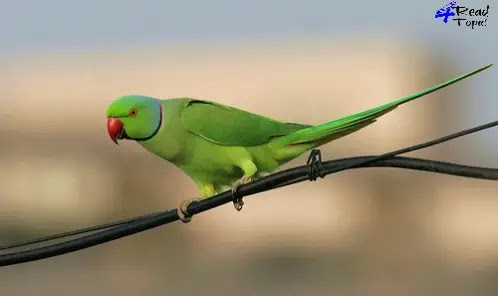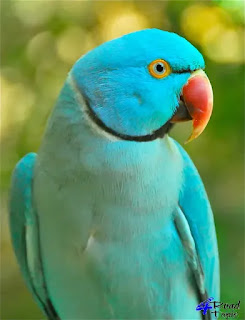The Durra Parakeet, Dora's collared parrot, or the domestic parakeet, also called the budgie, is one of the famous types of parrots, and it does not live naturally in the wild except in the dry and arid regions of the continent of Australia. The Durra is characterized by bright green feathers covering the front of its body, and its back and head covered with yellow and black interlaced feathers. Dura parrots live in the wild in large flocks that move with each other in search of food, and the size of these flocks varies according to the amount of food available. These birds can fly at great speed, and they build their nests in large colonies, and they give birth several times per year.
- the description
The length of an adult parrot is about 18 centimeters, and the weight of the female ranges between 24 to 40 grams, and the male is about 22 to 32 grams. These birds are characterized by pale green feathers covering the lower abdomen, and their wings are yellow, covered with black marks that are dark in adult birds and faint in chicks, and the rest of the head and face are yellow, and black marks on the head abound in juvenile parrots. The upper side of the beak is much larger than the lower one, so when it applies, the underside of it disappears completely, and the beak itself does not seem very prominent due to the thick feathers that cover it.
Before puberty, it is not possible to differentiate between male and female, as the genders are similar, but at the age of about eight months, signs of puberty begin to appear on these birds. Distinguishable, either by the absence of a collar or by the pupil.
- the food
Parrot birds eat most of what humans eat, in addition to ready-made food for parrots. It is important to change the parrot's water daily so that it does not become sticky or difficult to clean. It is sufficient to buy ready-made food for the parrot from pet stores, and this food consists of seeds whose scales will accumulate on the parrot’s food dish, and you can do a service for it by blowing over its plate to remove the eaten seed shells from it. This bird can also eat most of the human food, such as potatoes, carrots, broccoli, sunflower seeds, and all boiled vegetables and fruits, and it may be useful to provide at least one type of vegetable to it per day. Also, the parrot Durra is able to eat ready-made food, and he loves it very much, but presenting it to him may shorten his life due to its unhealthy effects.
- cage care
It is preferable that the cage of the parrot Al-Durra be as large as possible to give the bird enough space for movement, and if the goal of the cage is to keep a parrot under training, its door should be small and slightly narrow, to allow the bird to exit while holding only the hand of its owner. Usually, plastic or wooden perch is installed inside the cage to force the bird to always stand in the same place. In general, the cage should be placed in a place away from air currents and within a relatively constant temperature, and therefore, the parrot should never be placed near the front of a screen, a heater, or maybe an air conditioning system. The parrot Al-Durra is very sensitive to sudden changes in temperature. If it is exposed to so conditions, it is more likely to develop a cold, which may be quite harmful to its health.
It is useful to leave a cage of Dora’s parrot in the open air during the day, as this maintains the bird’s health in a better way, but it is necessary to pay attention, when taking it outside the house, that the cage always remains in the shade, and it must be brought into the house again when it gets dark before it gets exposed for the cold.
- reproduction
When wanting to breed Durra’s parrot at home, a bird of a good breed must first be chosen, then a harmonious pair must be chosen. As with all animals that are married at home, this process may require a great deal of effort and perseverance, as caring for the couple and then their chicks, and providing the appropriate space and conditions for them may not be an easy thing. These birds can start breeding when they reach one year of age, and they are able (if all goes well) to lay four to six eggs in each pregnancy, where the pregnancy takes about three weeks.
- Dealing with a parrot Durra
Durra's chicks are very sensitive, as the cage they live in must be cleaned twice a day, and they like foods containing wheat, mashed apples, and bread made with milk. This type of bird is generally very sympathetic, as it is familiar with its owner, loves to play with him and to stand on his shoulder, and is energetic and fast-moving, which suits his intense curiosity, as he loves to roam in the house and discover it, as he loves to present food to him by hand, caress him or wipe on his head. These birds represent an excellent choice for new parrot breeders because their requirements are few, their tolerance is relatively high, and they interact with their owners greatly.
Care must be taken to take care of the health of the parrot Al-Durra, and if it is noticed that the length of the claws of its feet has increased, it must be trimmed, because it begins to disturb the bird when it becomes too long, and it may become attached to parts of the cage and cause problems for it. These birds can be trained in different ways, and their training requires self-confidence, and it is necessary before starting training that the bird gets used to standing over the hand of its owner and dealing with it so that it is ready to jump on it when it is extended to it. After that, you can start shooting the bird around the house to accustom it to fly freely and return to its owner, paying attention to covering the breakable things in the rooms.



Comments
Post a Comment
You can write your comment here